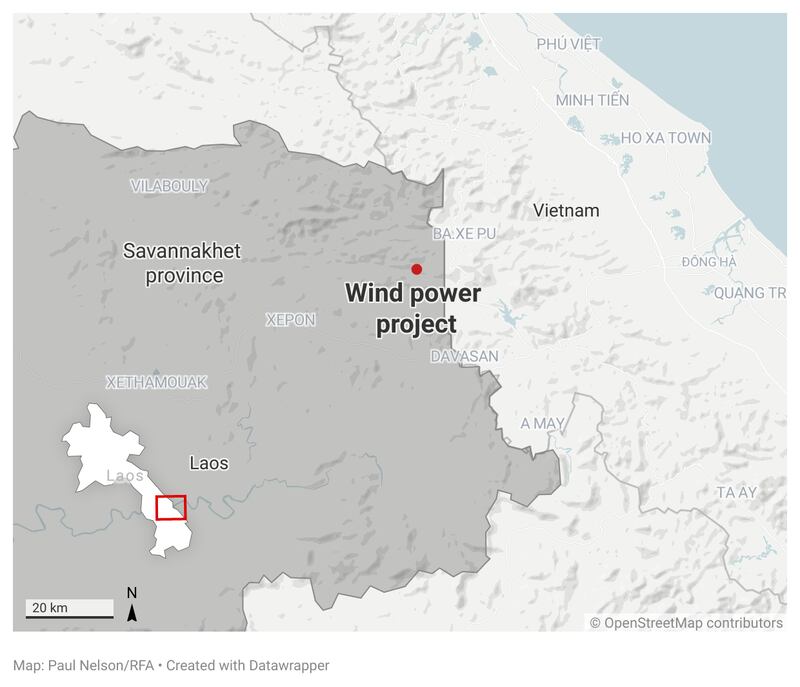Laos will construct one of Southeast Asia’s largest wind power farms near the Vietnamese border, government officials told Radio Free Asia, as part of its ambitious goal to become the “Battery of Southeast Asia.”
Authorities say the US$2.16 billion project will have limited impact on the environment – much less than the many dams that Laos is also building, which have displaced entire villages and devastated riparian ecosystems.
But some local officials and residents expressed concern about deforestation and loss of farmland, and called for more impact studies.
The 1,200-megawatt project by the Savan Vayu Renewable Energy Co. will break ground near Lako village in Sepon District in the southern province of Savannakhet. It will cover an area of 28,513 hectares, or about 110 square miles, which will be dotted with wind turbines by 2026, according to the plan.
When completed, it will be much larger than the 600-megawatt Monsoon Wind Project, also in Laos.
A district-level official of the Office of Energy and Mines said the area where the turbines will be built is rugged and that residents would be unaffected.
“The wind power farm will be located on top of the mountain, far away, about 20 kilometers [12 miles] from the village,” said the official, who like all sources in this report requested anonymity for personal safety reasons. “It won’t create any serious impact on the people. There will be no relocation of people.”
Reservations
But another district-level official from the Office of Agriculture and Forestry voiced reservations.
“If the company is going to build a wind power farm in the area, all the trees will be cut and all the forest will be destroyed,” he said. “On this issue, the feasibility study has not been detailed enough.”
A province-level official of the Natural Resources and Environment Department called for the government and the developer to exercise caution and perform an adequate impact assessment.
“People are going to lose a lot of farmland,” he said. “To avoid any problems or any conflict in the future, a well elaborated assessment is needed. We should do it right now. If not, it'll be more difficult to solve later.”

Residents had mixed feelings. One person said many people in the area support the project because it won’t affect the environment too much.
“We want to see the country develop and have enough power,” a resident said. “I think it is easy to build a wind power farm. The company just installs wind turbines along the Vietnamese border and that’s that.”
But a resident of Lako village said that more transparency was necessary.
“I know that the feasibility study on the project has been completed, but the potential impact on the environment and people are not publicly known,” the Lako resident said. “Right now, we don’t even know how much forest and how many people will be affected.”
Selling electricity to Vietnam
Construction on the project has not yet begun, an official from the Lao Ministry of Energy and Mines said.
“The company needs to have the power purchase agreement first before it can start construction,” the official said. “Most of the electricity produced by the project will be sold to Vietnam. I think the company might begin the construction of the basic infrastructure first.”
Laos and Vietnam have however signed an agreement in 2016 specifying that between 2020 and 2030 Laos will sell 5,000 megawatts of power to Vietnam.
RFA Lao reported in September that the Lao government also greenlighted a project for a Thailand-based company, to develop a 1,000-megawatt wind power farm in Sekong Province, also in southern Laos.
Meanwhile, in Vietnam’s central province of Quang Tri, the Hai Anh Wind Project signed an agreement with a Chinese developer to accept delivery of wind turbines by March, and for installation to be completed by November.
The Hai Anh Wind Project is one of around 30 such projects approved by Vietnam for Quang Tri’s mountainous Huong Hoa district. It covers 855 hectares (3 square miles) with an output of 40 megawatts.
Translated by Max Avary and An Nguyen. Edited by Eugene Whong and Malcolm Foster.
